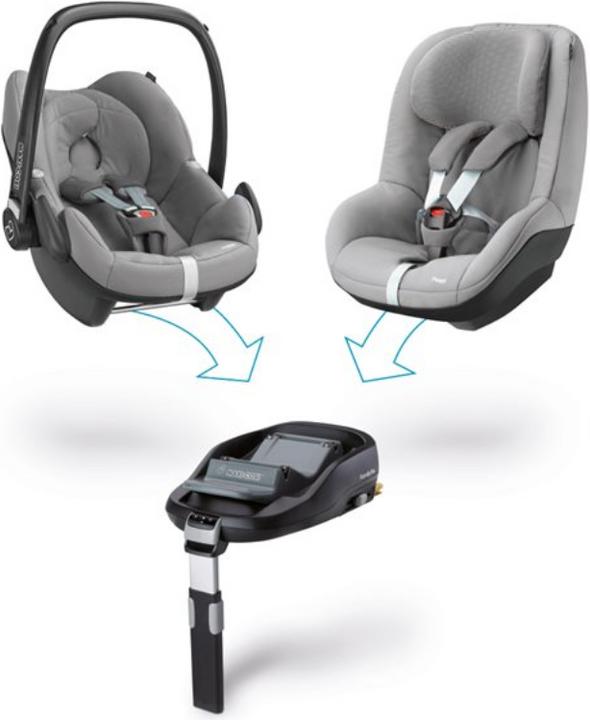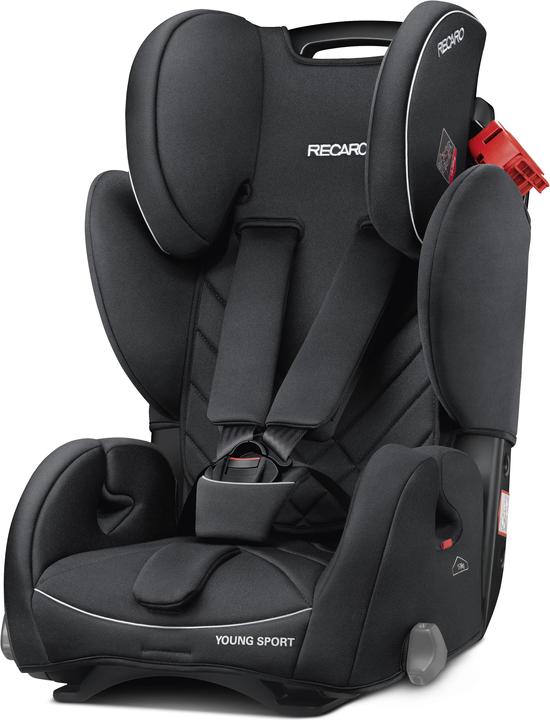

How to choose the right child car seat
When you buy a child car seat, there are a number of criteria you have to check off your list. Size, fitting options and direction are important for your child’s safety and should therefore be deciding factors in your choice of seat. However, quality, where the seat can be used and size adjustment options shouldn’t be underestimated either. We’ll help you narrow down your choice.
Let’s take a closer look at the three most important criteria
1. Child car seat size: baby car seat, child car seat or booster seat
First of all, you want to work out the right seat size for your little one. This depends on the size and weight of your child. Remember that the seat is only guaranteed to be safe if it is the right size. The TCS guide should give you more detailed information (in German). But in general, the following applies:
- Group 0 / 0+ (Birth to 18 months and 13 kg)
- Group 1 (9 months to 3.5 years and 9 to 18 kg)
- Group 2 – 3 (4 to 12 years and 15 to 36 kg)
- Booster seats (4 to 12 years and 15 to 36 kg)
2. Fitting options: Isofix, top tether or seat belt
If you want to attach a child seat with Isofix, you have to make sure your car comes with this function. As of 2014, it became regulation for all cars to have an Isofix system as standard. In older cars without Isofix, you can secure the seat with a seatbelt, also known as a three-point seat belt. There is the risk of you not attaching the seat belt properly. It might not be firm enough or it could be twisted. Nevertheless, this method is flexible and can be used in every car. In comparison, the child car seat with Isofix is quick and easy to fit, and most importantly, you know it’s always attached properly. This means there’s a secure and stable connection between the child car seat and the car. With the help of the right base, the car seat can be permanently attached. An additional support leg or top tether increases stability and restricts the amount of forward movement, meaning your child is always safe.
3. Direction: facing backwards or forwards
Depending on the ECE group and fitting method, child car seats can either be attached facing or in the opposite direction of travel. Rearward-facing systems are safer for infants up to 18 months. In the event of a head-on collision, they support the head, neck and back better than forward-facing seats. For safety reasons, baby seats always have to be forward-facing. Make sure to deactivate the airbag if the baby is in the passenger seat. Child car seats for Group 1 and 2 are available in both versions. Those for Group 3 can only be fitted forward-facing.
Still not sure which model you need?
Our product manager Ümmü Baskin has compiled ten suggestions so you can see what options are available and compare different models. Happy shopping!
Baby seat – the all-in-one solution
This portable baby seat is perfect for newborns and four and a half year olds alike. This seat offers utmost safety thanks to the customisable fitting direction and Isofix or three-point seat belt. An adapter lets you attach the baby seat to the most popular prams, making this a great all-in-one solution.

Baby seat – fitted in a jiffy
Rated with 4 stars by TCS, this excellent baby seat from the 0+ Group can be attached to almost all prams. The Maxi-Cosi makes for a great travel system. Thanks to Isofix and the three-point seat belt, this rearward-facing seat lets your little one travel safely no matter what car you’re in. With the FamilyFix and 2wayFix Basis it is even quicker to fit. Just one click and you’re ready to go.
Child car seat – for ease of getting in and out
This seat can turn 360° to make it easier for your child to get in and out. Thanks to the rearward-facing option and adjustable seat that can be made smaller, this car seat is just as safe for newborns as it is for children up to the age of four. It covers Group 0 to 1 and is suitable for children up to 19 kg. This seat is attached with Isofix.
Child car seat – with integrated sound system
This child car seat can be used from 9 months to 12 years (Group 1 to 3 and 9 to 36 kg). It is especially good for older children thanks to the Recaro sound system. Loudspeakers are integrated into the headrest so children can listen to their own audio programmes. This seat is attached with Isofix or a three-point seat belt.
Child car seat – perfect for big families
This slimline child car seat is great for when more than one seat or person has to fit on to the back seat. It is suitable from 9 months to 12 years (Group 1 to 2). This seat is attached with a three-point seat belt.
Child car seat – with patented side impact protection system
The Rodifix from Group 2 to 3 boasts the patented AirProtect side impact protection system in the headrest. This reduces the risk of head injury by up to 20%. Thanks to Isofix, you can attach this child seat safely. There is also a seat belt for strapping your little one in. This seat is suitable for children from 3.5 to 12 years and from 15 to 36 kg.
Child car seat – the more cost-effective option
The Britax Römer Discovery SL is a slightly cheaper alternative in the Group 2 to 3 range. It’s also attached using Isofix or a three-point seat belt. The light seat shell makes swapping to different cars child’s play. This seat is suitable for children from 4 to 12 years and from 15 to 36 kg.
Booster seat – child car seat without sides
This booster seat in Groups 2 and 3 has no sides that would provide additional protection in the event of a side collision. The seat is attached with Isofix or three-point seat belt. It is perfect for grandparents or anyone else who has to do short drives with children between the ages of 3 and 12 and weighing 15 to 36 kg.
Booster seat – space-saving and quick to fit
The BubbleBum seat meets the strict ECE R44/04 standard despite it having no sides. It can be used as a booster seat in the car as well as at the kitchen table. Because it is inflatable, the BubbleBum can be stowed away quickly in a bag or hand luggage. You really can take it anywhere and use it almost straight away. Children from the age of 3 and 15 kg can be strapped in using the three-point seat belt.
Booster seat – the perfect travel companion for spur-of-the-moment road trips
The small and convenient Mifold is suitable from the age of 4 and 15 kg. As there is no side collision protection, this seat is primarily intended for spontaneous road trips. Rather than raising the child up, it makes the seat belt positioner fit the child’s size. This booster seat is perfect for car sharing, hire cars, taxis and grandparents’ cars.
Child car seats don’t fit in every car. That’s why child car seat manufacturers Recaro , Maxi-Cosi and Britax-Römer let you check if their models are compatible with your vehicle.
Have a look at our TCS child car seat test 2017
I’m the cook, cleaner, police officer, nurse, entertainer, motivator, author, storyteller, coach, organiser, chauffeur, lawyer and judge. To put it simply, I’m a mum to a daughter and not just a (Content) Manager at the office but also at home.






